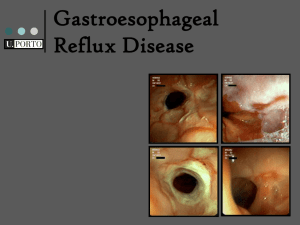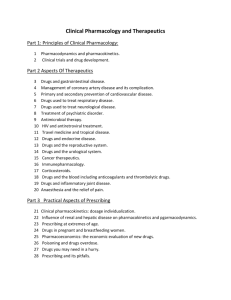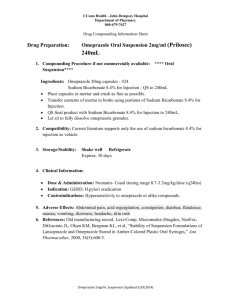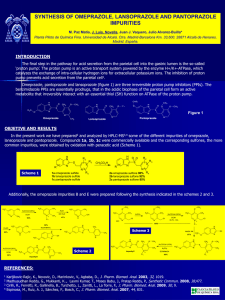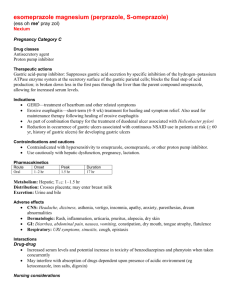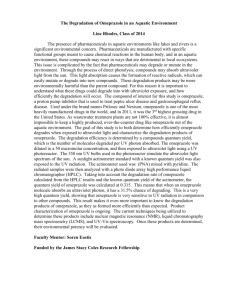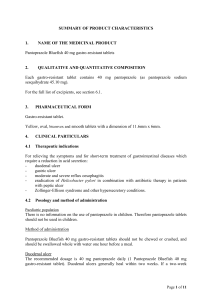References-final
advertisement
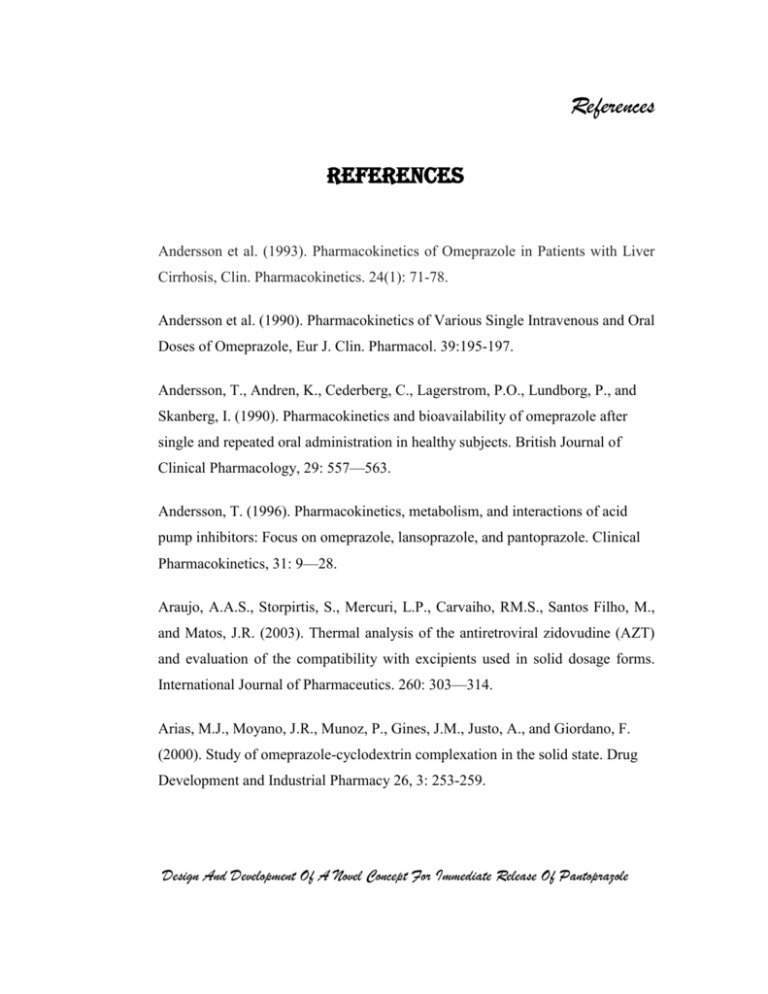
References REFERENCES Andersson et al. (1993). Pharmacokinetics of Omeprazole in Patients with Liver Cirrhosis, Clin. Pharmacokinetics. 24(1): 71-78. Andersson et al. (1990). Pharmacokinetics of Various Single Intravenous and Oral Doses of Omeprazole, Eur J. Clin. Pharmacol. 39:195-197. Andersson, T., Andren, K., Cederberg, C., Lagerstrom, P.O., Lundborg, P., and Skanberg, I. (1990). Pharmacokinetics and bioavailability of omeprazole after single and repeated oral administration in healthy subjects. British Journal of Clinical Pharmacology, 29: 557—563. Andersson, T. (1996). Pharmacokinetics, metabolism, and interactions of acid pump inhibitors: Focus on omeprazole, lansoprazole, and pantoprazole. Clinical Pharmacokinetics, 31: 9—28. Araujo, A.A.S., Storpirtis, S., Mercuri, L.P., Carvaiho, RM.S., Santos Filho, M., and Matos, J.R. (2003). Thermal analysis of the antiretroviral zidovudine (AZT) and evaluation of the compatibility with excipients used in solid dosage forms. International Journal of Pharmaceutics. 260: 303—314. Arias, M.J., Moyano, J.R., Munoz, P., Gines, J.M., Justo, A., and Giordano, F. (2000). Study of omeprazole-cyclodextrin complexation in the solid state. Drug Development and Industrial Pharmacy 26, 3: 253-259. Design And Development Of A Novel Concept For Immediate Release Of Pantoprazole References Avner DL. (2000). Clinical experience with pantoprazole in gastroesophageal reflux disease. Clin. Ther. 22:1169–1185; discussion 1149–1150. Balaban, D.H., and Peura, D.A. (1997). In Gastrointestinal Infections, Diagnosis and Management LaMont, J.T. (Ed). New York: Marcel Dekker. p. 29-69. Barie et al. (1992), Therapeutic Use of Omeprazole for Refractory Stress induced Gastric Mucosal Hemorrhage, Crit. Care Med., 20:899-901. Barry E Gidal. (2006). Drug absorption in the elderly: Biopharmaceutical considerations for the antiepileptic drugs. Epilepsy Research. 68S: S65–S69. Berntsson, P.B., Carisson, S.A.I., Garberg, L.E., Junggren, U.K., Sjostrand, S.E. and Von Wittken Sundell, G.W. (1977). Substituted 2- benzimidazoles with gastric acid secretion inhibiting effects. US Patent No. 4,045,563 AB Hassle. Besancon, M., Simon, A., Sachs, G., and Shin, J.M. (1997). Sites of reaction of the gastric H+K+-ATPase with extracytoplasmic thiol reagents. Journal of Biological Chemistry. 272 (22): 438-446. Borenstein, M.R. (2001). Handout for Pharmaceutical Analysis, Infrared Spectroscopy. Bowtle, W. (2002). Options in materials for liquid-filled capsules. Pharmaceutical Manufacturing and Packing Sourcer. http://www.samedanltd.com. Bowtle, W. (2003). Advances in liquid fill capsule technology. Business Briefing: Pharmatech. 1-4. Design And Development Of A Novel Concept For Immediate Release Of Pantoprazole References Bramhankar D.M., Jaiswal S.B. (1998). Biopharmaceutics and Pharmacokinetics: A Treatise, 5th edition. Vallabh Prakashan, Delhi. Bruni, G., Amici, L., Berbenni, V., Marini, A., and Orlandi, A. (2002). Drugexcipient compatibility studies, search of interaction indicators. Journal of Thermal Analysis and Calorimetry. 68: 56 1-573. Brunton, (1990). Agents for the Control of Gastric Acidity and Treatment of Peptic Ulcers, IN, Goodman AG, et al. The Pharmacologic Basis of Therapeutics. (New York, p. 907). Brunton, L.L. (1996). Agents for control of gastric acidity and treatment of peptic ulcers. In: Hardman, J.G., Limbird, L.E. (Eds). Goodman & Gilman’s The Pharmacological Basis of Therapeutics, New York, McGraw-Hill, pp. 90:1-13. Calabrese, C., Fabbri, A., DiFebo, G. (2007). Long-term management of GERD in the elderly with pantoprazole. Clin Interv Aging. 2: 85–92. Carao, J.J., Salas, M., and Ward, A. (2001). Healing and relapse rates in gastroesophageal reflux disease treated with the newer proton pump inhibitors lansoprazole, rabeprazole, and pantoprazole compared with omeprazole, ranitidine, and placebo: Evidence from randomized clinical trials. Clinical Therapeutics. 23, 7: 998-1017. Castell, D., Bagin, R., Goldlust, B. (2005). Comparison of the effects of immediate-release omeprazole powder for oral suspension and pantoprazole delayed-release tablets on nocturnal acid break-through in patients with symptomatic gastroesophageal reflux. Aliment. Pharmacol. Ther. 21: 1467–1474. Design And Development Of A Novel Concept For Immediate Release Of Pantoprazole References Cederberg, C., Ekenved, G., Lind, T., and Olbe, L. (1985). Acid inhibitory characteristics of omeprazole in man. Scandinavian Journal of Gastroenterology, 20(supplement 108): 105-112. Cederberg, C., Andersson, T., and Skanberg, I. (1989). Omeprazole: Pharmacokinetics and metabolism in man. Scandinavian Journal of Gastroenterology. 66: 33—40. Charman, W.N., Porter, C.J.H., Mithani, S., Dressman, J.B. (1997). Physicochemical and physiological mechanisms for the effects of food on drug absorption: the role of lipids and pH. J. Pharm. Sci. 86(3): 269-282. Cheer, S.M., Prakash, A., Faulds, D., Lamb, H.M. (2003). Pantoprazole: an update of its pharmacological properties and therapeutic use in the management of acid-related disorders. Drugs. 63: 101–133. Choi, H.G., and Kim, C.K. (2000). Development of omeprazole buccal adhesive tablets with stability enhancement in human saliva. Journal of Controlled Release. 68: 397-404. Chunqin Deng and Julia Graz, Generating Randomization Schedules Using SAS® Programming, Statistics and Data Analysis. Clissold, S.P. and Campoli-Richards, D.M. (1986). Omeprazole: A preliminary review of its pharmacodynamic and pharmacokinetic properties, and therapeutic potential in peptic ulcer disease and Zollinger-Ellison syndrome. Drugs.32: 15-47. Design And Development Of A Novel Concept For Immediate Release Of Pantoprazole References Committee for Proprietary Medicinal Products (CPMP), “Note for Guidance on the Investigation of Bioavailability and Bioequivalence”. London, 26 July 2001, CPMP/EWP/QWP/1401/98. Dammann, H., Von Kleist. (1997). Efficacy and tolerability of pantoprazole versus ranitidine and famotidine in patients with gastro-oesopghageal reflux disease: multicentre, open, randomised, control studies. International Clinical Practice Series. 15: 23–29. Dattilo, M., and Figura, N. (1998). Helicobacter pylori infection, chronic gastritis and proton pump inhibitors. Journal of Clinical Gastroenterology. 27 (Supplement 1): S 163-169. Dekkers, C.P., Beker, J.A., Thjodleifsson, B., Gabryelewicz, A., Bell, N.E., and Humphries, T.J. (1999). Comparison of rabeprazole 20 mg versus omeprazole 20 mg in the treatment of active duodenal ulcer: A European multicentre study. Alimentary Pharmacology and Therapeutics. 13:179—186. Der, G. (2003). An overview of proton pump inhibitors. Gastroenterology Nursing, 26, 5:182-90. Devault KR. (2007). Pantoprazole: a proton pump inhibitor with oral and intravenous formulations. Expert Rev. Gastroenterol. Hepatol. 1: 197– 205. Digenis, G.A., Gold, T.B., Shah, V.P. (1994). Cross-linking of gelatin capsules and its relevance to their in vitro-in vivo performance. Journal of Pharmaceutical Sciences. 83: 915-921. Design And Development Of A Novel Concept For Immediate Release Of Pantoprazole References Dimenas, E., Glise, H., Hallerback, B., Hernqvist, H., Svedlund, J., Wiklund, I. (1993). Quality of life in patients with upper gastrointestinal symptoms. An improved evaluation of treatment regimens. Scand. J. Gastroenterol. 28:681–687. Ehrlich, A., Luecker, P.W., Wiedemann, A., Sander, P., Huber, R., Mascher, H. (1999). Comparison of the pharmacodynamics and pharmacokinetics of pantoprazole (40 mg) as compared to omeprazole MUPS (20 mg) after repeated oral dose administration. Exp. Clin. Pharmacol. 21: 47–51. El-Serag, H.B., Petersen, N.J., Carter, J., Graham, D.Y., Richardson, P., Genta, R.M., and Rabeneck, L. (2004). Gastroesophageal Reflux Among Different Racial Groups in the United States. Gastroenterology. 126: 1692—1699. Enck, P., Dubois, D., Marquis, P. (1999). Quality of life in patients with upper gastrointestinal symptoms: results from the Domestic/International Gastroenterology Surveillance Study (DIGEST). Scand. J. Gastroenterol. Suppl. 231: 48–54. Fassihi, A.R., and Parker, M.S. (1988). Influence of gamma radiation on the gel rigidity index and binding capability of gelatin. Journal of Pharmaceutical Sciences. 7, 10: 876-879. Feliciano, D.V., Ojukwu, J.C., Rozycki, G Ballard, R.B., Ingram, W.L., Salomone, J., Namias, N., and Newman, P.G. (1999). The epidemic of cocainerelated pyloric perforations: With a comment on the importance of testing for Helicobacterpylori. Annals of Surgery. 229: 801—804. Design And Development Of A Novel Concept For Immediate Release Of Pantoprazole References Fitton, A., Wiseman, L. (1996). Pantoprazole: a review of its pharmacologic properties and therapeutic use in acid related disorders. Drugs. 51:460–82. Gallo, S., Dibildox, M., Moguel A. (1998). Clinical superiority of pantoprazole over ranitidine in the treatment of reflux esophagitis grade II and III. A prospective, double-blind, double-placebo study. Mexican clinical experience. Mexican Pantoprazole Study Group. Rev. Gastroenterol. Mex. 63: 11–16. Gan, K.H., Geus, W.P., BakkerW., Lamers, C.B.H.W., and Heijerman, H.G.M. (1996). In vitro dissolution profiles of enteric-coated microsphere/microtablet pancreatin preparations at different pH values. Alimentary Pharmacology and Therapeutics. 10, 5:771. Garnett, W.R. (2000). Management of peptic ulcer disease. http://www.aetna.com. GERD Information Resource Center. http://www.gerd.com/ sponsored by AstraZeneca LP. Gastroenterology. 95: 634—640. Glatzel, D., Abdel-Qader, M., Gatz, G., Pfaffenberger, B. (2006). Pantoprazole 40 mg is as effective as esomeprazole 40 mg to relieve symptoms of gastroesophageal reflux disease after 4 weeks of treatment and superior regarding the prevention of symptomatic relapse. Digestion.74: 145–154. Goh, K.L., Benamouzig, R., Sander, P., Schwan, T. (2007). Efficacy of Pantoprazole 20 mg daily compared with esomeprazole 20 mg daily in the maintenance of healed gastroesophageal reflux disease: a randomized, Design And Development Of A Novel Concept For Immediate Release Of Pantoprazole References doubleblind comparative trial–the emancipate study. Eur. J. Gastroenterol. Hepatol. 19:205–211. Gohel, M.C., and Jogani, P.D. (2005). A review of co-processed directly compressible excipients. Journal of Pharmacy and Pharmaceutical Sciences. 8, 1: 76-93. Gore, R. M. (2000). In: Modern Imaging of the Alimentary Tube. Margulis, A.R. (Ed.). Berlin, Springer. pp. 94-101. Graham, D.Y., and Malaty, H.M.(1999). Alendronate gastric ulcers. Alimentary Pharmacology and Therapeutics. 13: 513—519. Graham, D.Y., Lew, G.M., Klein, P.D., Evans, D.G., Evans, D.J., Saeed, Z.A., and Malaty, H.M. (1992). Effect of treatment of Helicobacter pylori infection on the long-term recurrence of gastric or duodenal ulcer: A randomized, controlled study. Annals of Internal Medicine. 116, 9: 705—708. Gray, H. (1985). Anatomy of the Human Body Philadelphia, Lea & Febiger. Guidance for Industry. Bioavailability and Bioequivalence Studies for Orally Administered Drug Products-General Considerations. U.S Department of Health and Human Services. Food and Drug Administration. Centre for Drug Evaluation and Research (CDER) March 2003, BP, Revision1 Hartmann, M., Theiss, U., Huber, R., et al. (1996).Twenty-four-hour intragastric pH profiles and pharmacokinetics following single and repeated oral Design And Development Of A Novel Concept For Immediate Release Of Pantoprazole References administration of the proton pump inhibitor pantoprazole in comparison to omeprazole. Aliment. Pharmacol. Ther.10:359–366. Helander, H.F. (1984). Parietal cell structure during inhibition of acid secretion. Scandinavian Journal of Gastroenterology. 19 (Supplement 101): 21-26. Hersey, S.J., and Sachs, G. (1995). Gastric acid secretion. Physiological Reviews, 75:155-189. Hirai, M., Azuma, T., and Ito, S. (1995). A proton pump inhibitor, E3810, has antibacterial activity through binding to Helicobacter pylori. Journal of Gastroenterology, 30: 461-464. Hogan, D., Pratha, V., Riff, D., et al. (2007). Oral pantoprazole in the form of granules or tablets are pharmacodynamically equivalent in suppressing acid output in patients with gastro-esophageal reflux disease and a history of erosive oesophagitis. Aliment. Pharmacol. Ther. 26:249–256. Holt, S., and Howden, C.W. (1991). Omeprazole: Overview and opinion. Digestive Diseases and Sciences, 36: 385—393. Holtmann, G. (2009). International validation of a health-related quality of life questionnaire in patients with erosive gastro-oesophageal reflux disease. Aliment Pharmacol. Ther. 29:615–625. Honkanen, 0. (2004). Biopharmaceutical Evaluation of Orally and Rectally Administered Hard Hydroxypropyl Methylcellulose Capsules. Academic Ph.D. Dissertation, University of Helsinki, Helsinki, Finland. Design And Development Of A Novel Concept For Immediate Release Of Pantoprazole References Horn, J. (2000). The proton-pump inhibitors: similarities and differences. Clinical Therapeutics, 22, 3: 266-80. Howden, C.W., Forrest, J.A., Meredith, P.A., Reid, J.L. (1985). Antisecretory effect and oral pharmacokinetics following low dose omeprazole in man. Br. J. Clin. Pharmacol. 20: 137–139. Howden, C.W., Meredith, P.A., Forrest, J.A., Reid, J.L. (1984).Oral pharmacokinetics of omeprazole. Eur. J. Clin. Pharmacol. 26: 641–3. Howden, C.W. (2005). Immediate-release proton-pump inhibitor therapy-potential advantages, Aliment. Pharmacol. Ther. 25-30. Howden, C.W. (1997). In Gastrointestinal Pharmacology and Therapeutics. Friedman, G., Jacobson, E.D., and McCallum, R.W. (Eds.). Philadelphia, Lippincott-Raven Publishers. pp. 45-54. Hoyumpa, A.M., Trevino-Alanis, H., Grimes, I., and Humphries, T.J. (1999). Rabeprazole: Pharmacokinetics in patients with stable, compensated cirrhosis. Clinical Therapeutics, 21: 691—701. http://www.emedicine.com Humphries, T.J., and Merritt, G.J. (1999). Drug interactions with agents used to treat acid-related diseases. Alimentary Pharmacology and Therapeutics. 13(Supplement 3): 18—26. ICH Harmonized Tripartite Guideline. (2003). Stability testing of new drug substances and products Q1A(R2), ICH Steering Committee. Jeffrey owen Philips, Ashland MO. (2002). US patent 6,489,346 B1. Design And Development Of A Novel Concept For Immediate Release Of Pantoprazole References Jennings, D. (1940). Perforated peptic ulcer: changes in age-incidence and sexdistribution in the last 150 years. Lancet. 1: 395- 447. Midha, K., Blume, H. (1992). “Bio-International, Bioavailability, Bioequivalence and Pharmacokinetics”, International conference of F.I.P., “Bio-International ‘92” held in Bad Homburg, Germany, May 20-22, Scientific Publishers Stuttgart. Kahrilas, P.J., Shaheen, N.J., Vaezi, M.F. (2008). American Gastroenterological Association Medical Position Statement on the management of gastroesophageal reflux disease. Gastroenterology. 135: 1383–1391. Kaspari, S., Kupcinskas, L., Heinze, H., et al. (2005). Pantoprazole 20 mg on demand is effective in the long-term management of patients with mild gastrooesophageal reflux disease. Eur. J. Gastroenterol. Hepatol. 17:935–41. Katz, P.O., Anderson, C., Khoury, R., Castell, D.O. (1998). Gastro-esophageal reflux associated with nocturnal gastric acid breakthrough on proton pump inhibitors. Aliment. Pharmacol. Ther. 12: 1231–1234. Kawano, S., Murata, H., and Tsuji, S. (2002). Randomized comparative study of omeprazole and famotidine in reflux esophagitis. Journal of Gastroenterology and Hepatology. 17, 9: 955-959. Kethu, S.R., and Moss, S.F. (2004). Gastritis and peptic ulcer disease. In: Conn’s Current Therapy Rakel, R.E., and Bope, E.T. (Eds.), W.B. Saunders, Philadelphia, PA, 542-544. Design And Development Of A Novel Concept For Immediate Release Of Pantoprazole References Koerner, T. (2002). Comparable efficacy of pantoprazole 40 mg vs omeprazole MUPS 40 mg in patients with GERD II/III. Gut.; 51:A166. Kovacs, T.O., Wilcox, C.M., DeVault, K., Miska, D., Bochenek, W. (2002). Comparison of the efficacy of pantoprazole vs nizatidine in the treatment of erosive esophagtitis: a randomized active-controlled, double blind study. Aliment. Pharmacol. Ther. 16: 2043–2052. Kromer, W., Kruger, U., Huber, R., et al. (1998). Differences in pH-dependent activation rates of substituted benzimidazoles and biological in vitro correlates. Pharmacology. 56:57–70. Kurata, J.H., and Nogawa, A.N. (1997). Meta-analysis of risk factors for peptic ulcers: Nonsteroidal anti-inflammatory drugs, Helicobacter pylori and smoking. Journal of Clinical Gastroenterology. 24: 2—17. Landahl et al., (1992). Pharmacokinetics Study of Omeprazole in Elderly Healthy Volunteers, Clin. Pharmacokinetics. 23 (6): 469-476. Larsson, H., Mattson, H. and Sundell, G. (1985). Structure activity relationship of substituted benzimidazoles. Scandinavian Journal of Gastroenterology. 20 (Supplement 8): 23-35. Laurtisen. (2000). Comparable efficacy of pantoprazole and omeprazole to prevent relapse in patients with GERD. Gut. 47 Suppl III: 39(A60). Lentner C, Basle. 1999. CIBA GEIGY, Units of measurement, Body fluids, Composition of the body, Nutrition, Geigy Scientific Tables (1981) 1:123-133; Design And Development Of A Novel Concept For Immediate Release Of Pantoprazole References yamada, Tadataka (ed.), “Text book of Gastroenterology”, Volume 1, Lippincott Williams & Wilkens, pp 284-285. Levine, M.S. (2000). In Textbook of Gastrointestinal Radiology Gore, R.M., and Levine, M.S. (Eds). Philadelphia: W.B. Saunders Company. pp 5 14-516. Lew, E.A. (1999). Pharmacokinetic concerns in the selection of anti-ulcer therapy. Alimentary Pharmacology and Therapeutics. 13 (Supplement 5): 11—16. Li, C.L., Martini, L.G., Ford, J.L., and Roberts, M. (2005). The use of hypromellose in oral drug delivery. Journal of Pharmacy and Pharmacology 57, 5: 533-546. Lindberg, P., Nordberg, P., Alminger, T., Brandstrom, A., and Walimark, B. (1986). The mechanism of action of the gastric acid secretion inhibitor omeprazole. Journal of Medicinal Chemistry. 29, 8: 1327-1329. Lovgren, K. I., Pilbrant, A.G., Yasumura, M., Morigaki, S., Oda. M., and Ohishi, N. (1988). Pharmaceutical preparation for oral use. US Patent No. 4,786,505 AB Hassle. Lowe, C.E., Depew, W.T., Vanner, S.J., Paterson, W.G., and Meddings, J.B. (2000). Upper gastrointestinal toxicity of alendronate. American Journal of Gastroenterology. 95: 634—640. Marshall, B.J., and Warren, J.R. (1984). Unidentified curved bacilli in the stomach of patients with gastritis and peptic ulceration. Lancet. 1, 8390: 1311-13 15. Design And Development Of A Novel Concept For Immediate Release Of Pantoprazole References Marshall, B.J. (1994). Helicobacterpylori. American Journal of Gastroenterology. 89 (Supplement): S116—S 128. Martin de Argila C. (2005). Safety of potent gastric acid inhibition. Drugs. 65(Suppl 1):97-104. McQuaid K., Laine L. (2005). Early heartburn relief with proton pump inhibitors: a systematic review and meta-analysis of clinical trials. Clin. Gastroenterol. Hepatol. 3:553-63. Mendes, C.A.M., and De Sousa, G.J.P. (2000). Inclusion amino acid salts compounds of benzimidazole derivatives with cyclodextrins, their preparation and pharmaceutical formulations containing them. EP Patent No. 1018340. Metz, D.C., Pratha, V, Martin, P., et al. (2000). Oral and intravenous dosage forms of pantoprazole are equivalent in their ability to suppress gastric acid secretion in patients with gastroesophageal reflux disease. Am. J. Gastroenterol. 95:626–633. Morçol, T., Nagappan, P., Nerenbaum, L., Mitchell, A., and Bell, S.J.D. (2004). Calcium phosphate-PEG-insulin-casein (CAPIC) particles as oral delivery systems for insulin, International Journal of Pharmaceutics. 277, 9:1—97. Mulder, C.J., Westerveld, B.D., Smit, J.M., et al. (2002). A double-blind, randomized comparison of omeprazole Multiple Unit Pellet System (MUPS) 20 mg, lansoprazole 30 mg and pantoprazole 40 mg in symptomatic reflux esophagitis followed by 3 months of omeprazole MUPS maintenance treatment: a Dutch multicentre trial. Eur. J. Gastroenterol. Hepatol. 14: 649–656. Design And Development Of A Novel Concept For Immediate Release Of Pantoprazole References Munson, K., Lambrecht, N., Shin J.M., and Sachs, G. (2000). Analysis of the membrane domain of the gastric H+ /K+ ATPase, Journal of Experimental Biology. 203: 161 - 170. Nagata, S. (2002). Advantages to HPMC Capsules: A New Generation. Drug Delivery and Technology. 2, 2: 34-39. Nagata, S., and Tochio, S. (2002). The influence of the composition of the test fluids on dissolution from HPMC capsules, Poster Presentation. AAPS annual meeting and exposition. Nahao, M., and Malfertheiner, P. (1998). Growth inhibitory and bactericidal activities of lansoprazole compared with those of omeprazole and pantoprazole against Helicobacter pylori. Helicobacter. 3: 21-27. Nakagawa, et al. (1991), Lansoprazole: Phase I Study of lansoprazole (AG -1749) Anti - ulcer Agent, J. Clin. Therapeutics & Med. OECD Series on Principles of Good Laboratory Practice and Compliance Monitoring, Number 1. “The OECD Principles of Good Laboratory Practice”, Environment Monograph No. 45, Paris 1992. Ogura, T., Furuya, Y., and Matsuura, S. (1998). HPMC capsules — an alternative to gelatin. Pharmaceutical Technology. 11: 32-42. Orr, W.C. (2005). Night-time gastro-esophageal reflux disease: prevalence, hazards, and management. Eur. J. Gastroenterol. Hepatol. 17: 113–120. Design And Development Of A Novel Concept For Immediate Release Of Pantoprazole References Ours, T.M., Fackler, W.K., Richter, J.E., Vaezi, M.F. (2003). Nocturnal acid breakthrough: Clinical significance and correlation with esophageal acid exposure. Am. J. Gastroenterol. 98(3): 545–550. Paul W. (2000). Pantoprazole: A New Proton Pump Inhibitor. Clinical Therapeutics. 22: 1268-1293. PDR (Physician’s Reference Desk), (2004). Montvale, NJ, Thomson PDR. Peghini, P.L., Katz, P.O., Bracy, N.A., Castell, D.O. (1998). Nocturnal recovery of gastric acid secretion with twice daily dosing of proton pump inhibitors. Am. J. Gastroenterol. 93: 763–767. Petersen, K.U. (1995). Omeprazole and the cytochrome P450 system. Alimentary Pharmacology and Therapeutics. 9: 1—9. Pichard, L., Curi-Pedrosa, R., Bonfils, C., Jacqz-Aigrain, E., Domergue, J., Joyeux, H., Cosme, J., Guengerich, F.P., and Maurel, P. (1995). Oxidative metabolism of lansoprazole by human liver cytochromes P450. Molecular Pharmacology. 47: 410—418. Pilbrant, A., and Cederberg, C. (1985). Development of an oral formulation of omeprazole. Scandinavian Journal of Gastroenterology. 20 (Supplement 108): 113-120. Pillay, V., and Fassihi, R. (2001) Probing the dynamics of matrix hydration in the presence of electrolytes. Drug Delivery. 8, 2: 87-92. Design And Development Of A Novel Concept For Immediate Release Of Pantoprazole References Podczeck, F., and Jones, B.E. (2004) Pharmaceutical Capsules; Pharmaceutical Press:London. Poole P. (2001). Pantoprazole. Am. J. Health Syst. Pharm. 58: 999– 1008. Quali-V® HPMC capsules, Technical Manual (2004). Shionogi Qualicaps, Inc. http://www.gualicaps.com. Ralph E Small. (2005). Advances in Proton Pump Inhibitor Therapy: An Immediate-Release Formulation of Omeprazole, P&T. 30(12): 698-713. Rang, H.P., Dale, M.M., Ritter, J.M., and Gardner, P. (1995). Pharmacology, New York, Churchill Livingstone, Inc., 385-388. Regardh et al. (1990). The Pharmacokinetics of Omeprazole in Humans—A Study of Single Intravenous and Oral Doses, Ther. Drug Mon. 12:163-72. Richter, J.E., Fraga, P., Mack, M., Sabesin, S.M., Bochenek, W. (2004). Prevention of erosive esophagitis relapse with pantoprazole. Aliment. Pharmacol. Ther. 20: 567–575. Robertson, M. I. (1999). Regulatory Issues with Excipients. International Journal of Pharmaceutics. 187: 273-276. Roll, J., Weng, A., and Newman, J. (1997). Diagnosis and treatment of Helicobacter pylori infection among California Medicare Patients. Archives of Internal Medicine. 157: 994—998. Design And Development Of A Novel Concept For Immediate Release Of Pantoprazole References Rowe, R.C., Sheskey, P.J., Quinn, M.E. (eds), Pharmaceutical Excipients 5. [CDROM] London: Pharmaceutical Press, 2009. Rowe, R.C., Sheskey, P.S., and Weller, P.J. (2003). Handbook of Pharmaceutical Excipients; Pharmaceutical Press: London. Ryan-Harshman, M., and Aldoori, W. (2004). How diet and lifestyle affect duodenal ulcers. Review of the evidence. Canadian Family. 50: 727-32. Sachs, G., Munson, K., Hall, K., and Hersey, S.J. (1990). Gastric H+ K+ ATPase as a therapeutic target in peptic ulcer disease. Digestive Diseases and Sciences. 35: 1537—1544. Sachs, G., Shin, J.M., Besancon, M., et al. (1993). The continuing development of gastric acid pump inhibitors. Aliment. Pharmacol. Ther. 7: 4–12. Sachs, G. (1997). Proton pump inhibitors and acid-related diseases. Pharmacotheraphy. 17: 22–37. Sachs, G., (2003). Physiology of the parietal cell and therapeutic implications, Pharmacotherapy. 23, 10-2: 68S-73S. Sarisuta, N., and Kumpugdee, M. (2000). Crystallinity of omeprazole in various film polymers. Pharmacy and Pharmacology Communications. 6: 7-11. Scholten T. (2000). Pantoprazole 40 mg relieves primary reflux symptoms more rapidly than omeprazole MUPS 20 mg in patients with severe GERD symptomatology. Gastroenterology. 118: A1303. Design And Development Of A Novel Concept For Immediate Release Of Pantoprazole References Scholten, T., Dekkers, C.P.M., Schutze, K., et al. (2005). On-demand therapy with pantoprazole 20 mg as effective long term management of reflux disease in patients with mild GERD: the Orion trial. Digestion. 72:76–85. Scholten, T., Teutsch, I., Bohuschke, M., Gatz, G. (2007). Pantoprazole ondemand effectively treats symptoms in patients with gastro-esophageal reflux disease. Clin. Drug Investig. 27:287–296. Schreiber, S., Nguyen, T.H., Stüben, M., and Scheid, P. (2000). Demonstration of a pH gradient in the gastric gland of the acid-secreting guinea pig mucosa. American Journal of Physiology. Gastrointestinal and liver physiology. 279, 3: G597-G604. Scott, M., and Gelhot, A.R. (1999). Gastroesophageal Reflux Disease: Diagnosis and Management. American Family Physician. 3: 1161-1176. Seth, P. (2001). Pharmaceutical composition containing an acid-labile omeprazole and process for its preparation. US Patent No. 6,248,355 Schwarz Pharma AG. Shayne, P. (2004). Gastritis and peptic ulcer disease. eMedicine.com, Inc. Sheppard, S.E., Houck, R.C., and Dittmar, C. (1942). The Sorption of Soluble Dyes by Gelatin. Journal of Physical Chemistry. 46, 158-176. Sherman, A., and Bini, E.J. (1999). Pill-induced gastric injury. American Journal of Gastroenterology. 94, 2: 511-513. Shi, S., Klotz, U. (2008). Proton pump inhibitors: an update of their clinical use and pharmacokinetics. Eur. J. Clin. Pharmacol. 64: 935–951. Design And Development Of A Novel Concept For Immediate Release Of Pantoprazole References Shike, M., Gillin, J.S., Kemeny, N., Daly, J.M., and Kurtz, R.C. (1986). Severe gastroduodenal ulcerations complicating hepatic artery infusion chemotherapy for metastatic colon cancer. American Journal of Gastroenterology. 81: 176—179. Simmons, T.C., Hogan, D.L., Selling, J.A., Maxwell, V., Isenberg, J.I. (1986). The effect of sodium bicarbonate versus aluminum-magnesium hydroxide on postprandial gastric acid in duodenal ulcer patients. J. Clin. Gastroenterol. 86(2): 146-149. Simon, B., Muller, P., Pascu, O., Gatz, G., Sander, P., Huber, R., Mascher, H. (2003). Intra-esophageal pH profiles and pharmacokinetics of Pantoprazole and esomeprazole: a crossover study in patients with gastroesophageal reflux disease. Eur. J. Gastroenterol. Hepatol.15: 791–799. Sjostrand, S.E. and Junggren, U.K. (1979). Substituted pyridylsulfinyl benzimidazoles having gastric acid secretion properties, pharmaceutical preparations containing same, and intermediates for their preparation. EP Patent No. 0005129 AB Hassle. Smout, A.J.P.M., Van der Schee, E.J., and Grashuis, J.L. (1980). What is measured in electrogastrography? Dig Diseases and Sciences. 25: 179-88. Snape, W.J. (2000). Disorders of Gastrointestinal Motility. In: Goldman, L., and Bennett, J.C. Cecil Textbook of Medicine Philadelphia, PA, W. B. Saunders Company. Design And Development Of A Novel Concept For Immediate Release Of Pantoprazole References Soll, A.H. (1993). Gastric duodenal and stress ulcer. In: Gastrointestinal Disease: Pathophysiology Diagnosis Management Sleisenger, M.H., and Fordtran, J.S. (Eds.). WB Saunders, Philadelphia, PA, 580—679. Solvell, L. (1990). The clinical safety of omeprazole. Digestion. 47 (Supplement 1): 59-63. Spechler, S.J. (2002). Peptic ulcer disease and its complications. In: Sleisenger & Fordtran’s Gastrointestinal and Liver Disease Feldman, M., Friedman, L.S., and Sleisenger, M.H. (Eds.), W.B. Saunders, Philadelphia, pp. 747-796. Tabata, T., Makino, T., Kashihara, T., Hirai, S., Kitamori, N., and Toguchi, H. (1992). Stabilization of new antiulcer drug (lansoprazole) in the solid dosage forms. Drug Development and Industrial Pharmacy. 18, 13: 1437-1447. Takumurá, T., and Machida, Y. (2001). UV absorption should not he applied for determining amoxicillin in acidic dissolution test medium. International Journal of Pharmaceutics. 228:1-4. Talukder, R. (2004). Design and development of a rupturable drug delivery system for delivering drug to the distal gastrointestinal tract-colon. Ph.D. Dissertation. Temple University School of Pharmacy, Philadelphia, PA. Tanaka, M., Ohkubo, T., Otani, K., et al. (2001). Stereoselective pharmacokinetics of pantoprazole, a proton pump inhibitor, in extensive and poor metabolizers of S-mephenytoin. Clin. Pharmacol. Ther. 69: 108–113. Design And Development Of A Novel Concept For Immediate Release Of Pantoprazole References University of Michigan, Medicinal Chemistry Group. (2004). Introduction to Penicillins http://www.sitemaker.umich.edu/medchemgroup4/files/j USP 28/ NF 23. (2005). United States Pharmacopoeial Convention, Inc. Rockville. Van Rensburg, C.J., Honiball, P.J., Van Zyl, J.H., et al. (1999). Safety and efficacy of pantoprazole 40 mg daily as relapse prophylaxis in patients with healed reflux esophagitis – a 2-year follow-up. Aliment. Pharmacol. Ther. 13:1023–1028. Verma, R.K., and Garg, S. (2005). Selection of excipients for extended release formulations of glipizide through drug-excipient compatibility testing. Journal of Pharmaceutical and Biomedical analysis. 38: 633-644. Volberding, P.A., and Mitsuyasu, R. (1985). Recombinant interferon alpha in the treatment of acquired immune deficiency syndrome-related Kaposi’s sarcoma, Seminars in Oncology. (Supplement 5): 2-6. Walsh, J.H., and Peterson, W.L. (1995). The treatment of Helicobacter pylon infection in the management of peptic ulcer disease. New England Journal of Medicine. 333: 984—991. Weidolf, L., and Castagnoli, N. (2001). Study of the electrospray ionization mass spectrometry of the proton pump inhibiting drug Omeprazole. Rapid Communications in Mass Spectrometry. 15: 283-290. Design And Development Of A Novel Concept For Immediate Release Of Pantoprazole References Wei-Youh Kuua, Rao Chilamkurtia, Chi Chenb. (1998). Effect of relative humidity and temperature on moisture sorption and stability of sodium bicarbonate powder. Int. J. Pharm. 167-175. Yasuda, S., Ohnishi, A., and Ogawa, T., (1994). Pharmacokinetic properties of E3810, a new proton pump inhibitor, in healthy male volunteers. International Journal of Clinical Pharmacology and Therapeutics. 32: 466-473. Design And Development Of A Novel Concept For Immediate Release Of Pantoprazole
